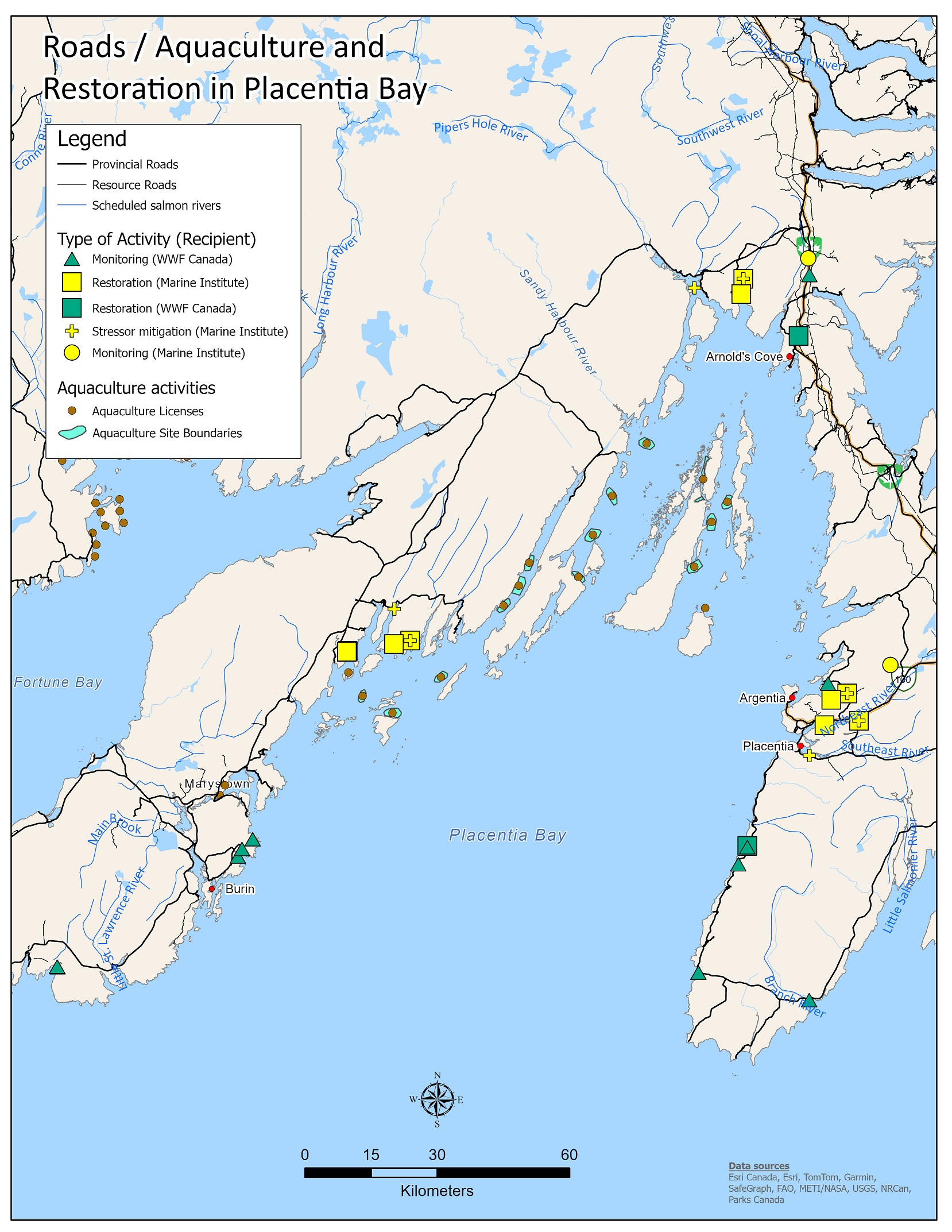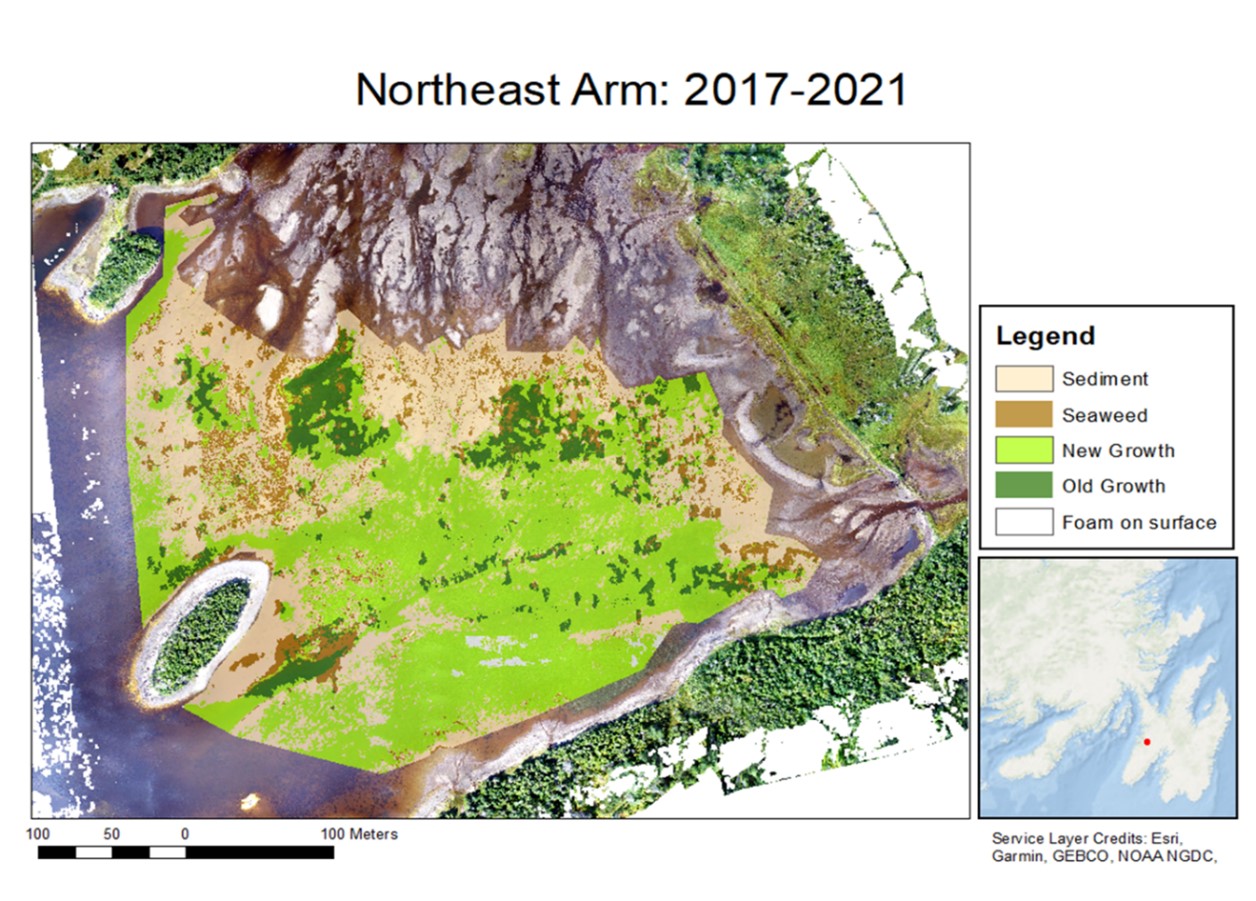Habitat Highlight: Restoring fish habitat in Newfoundland and Labrador, with a Placentia Bay case study
This Habitat Highlight gives an overview of the restoration projects in Newfoundland and Labrador (NL) that were funded by Fisheries and Oceans Canada’s (DFO) Coastal Restoration Fund and highlights the results of a project undertaken by the Fisheries and Marine Institute of Memorial University of Newfoundland (Marine Institute) to enhance the Placentia Bay ecosystem.
On this page
- Coastal Restoration Fund projects in Newfoundland and Labrador
- Restoring a healthy Placentia Bay coastal ecosystem
- What can you do to help?
- Future habitat restoration activities
- References
Coastal Restoration Fund projects in Newfoundland and Labrador
The restoration of fish habitat aims to repair past harm. It also helps fish populations recover from key threats. The Coastal Restoration Fund operated from 2017 to 2022. It supported projects that helped to restore coastal aquatic habitats across Canada. The fund backed four projects in these areas of Newfoundland and Labrador (NL), as shown in Figure 1:
- South Coast of Labrador
- West Coast of Newfoundland
- South Coast of Newfoundland in Conne River (Miawpukek)
- Placentia Bay, NL

Figure 1 – Text version
Table 1: CRF funding recipients and the location and type of CRF activities shown in Figure 1
Table as data source for figure
| Recipient of CRF funding | Location | Type of activity |
|---|---|---|
Marine Institute |
Placentia Bay |
Restoration, stressor mitigation, monitoring |
World Wildlife Fund (WWF) Canada |
Southern Labrador, Northern Peninsula, Burin Peninsula, Avalon Peninsula, Placentia Bay |
Restoration, monitoring, engagement |
Mi’kmaq Alsumk Mowimsikik Kogoey Association (MAMKA) |
Conne River |
Restoration |
Humber Arm Environmental Association |
Bay of Islands, NL |
Restoration, monitoring |
One of these projects was led by an Indigenous group located in the province. The group is called Mi’kmaq Alsumk Mowimsikik Kogoey Association (MAMKA). The other 3 projects involved Indigenous engagement and partnerships. These projects included:
- stabilization of a clay bank to reduce sedimentation in an important Atlantic Salmon bearing river
- restoration of a capelin spawning beach
- eelgrass revegetation and artificial reef placement
- freshwater barrier mitigation
Additional information on each project can be found on the NL page of the Coastal Restoration Fund website.
DFO’s Fish and Fish Habitat Protection Program staff in NL help support DFO’s national funding programs, like the Coastal Restoration Fund. They contribute to priority-setting and work with potential recipients of funding to ensure their proposed projects will benefit priority species and places. They also evaluate proposals and set up funding agreements. We are working to modernize the tools we use for priority-setting and decision-making to support DFO’s national funding programs. For example, we are incorporating geomatics tools.
Restoring a healthy Placentia Bay coastal ecosystem
About Placentia Bay
Placentia Bay is home to many seabird species and diverse marine life. It also serves as a nursery area for Atlantic Cod, and Atlantic Salmon migrate into the rivers that flow into the Bay.
Placentia Bay is currently one of the largest oil handling ports in Canada and experiences a high volume of marine vessel traffic annually. Over the last 20 years the region has also experienced continued growth in coastal development, oil and gas transportation and marine shipping. In addition, there has been an increase in aquaculture activity and interest. While these commercial activities support a strong economy, they also present risks to the health of the Placentia Bay coastal ecosystem.
Aquatic invasive species are another key threat to the fish and fish habitat in Placentia Bay. The highly invasive European Green Crab has been detected in the bay since 2007Footnote 1. The crab destroys eelgrass, an ecologically significant species and valuable fish habitat, while foraging for its prey in the sediment below.
Placentia Bay has become a priority area for habitat restoration. DFO contributed Coastal Restoration Funding of $4.7 million towards a large project led by the Fisheries and Marine Institute of Memorial University of Newfoundland (Marine Institute) between 2017 and 2022 to restore eelgrass beds, enhance fish habitat and mitigate stressors in the region. Despite the limitations associated with COVID-19 in visiting and working with coastal communities, the now completed project has created a legacy through the outreach, capacity building and knowledge sharing activities including:
- Training project members and partners (Miawpukek First Nation) on eelgrass restoration
- Delivering presentations at high schools and conferences (20 total)
- Creating a Marine Institute – Coastal Restoration video which is shared on the Marine Institute’s YouTube channel to over 1,000 subscribers
- Supporting 4 graduate students working on theses related to the project
The various project activities undertaken by the Marine Institute are shown in Figure 2, in relation to other features such as the road network, CRF-funded WWF projects and aquaculture sites. The Marine Institute project activities are explained in more detail below.

Figure 2 – Text version
Table 2: Location and type of Coastal Restoration Fund projects in Placentia Bay as shown in Figure 2
Table as data source for figure
| Type of activity | Location | Recipient of CRF funding |
|---|---|---|
Restoration, monitoring |
Marystown/Burin, Head of Placentia Bay, Southwest Avalon |
WWF Canada |
Restoration, stressor mitigation, monitoring |
Argentia/Placentia/Dunville, |
Marine Institute |
Aquaculture licenses |
Belleoram/Chapel Island, Fortune Bay |
N/A |
Aquaculture licenses and Aquaculture site boundaries |
Merasheen Island/NW Placentia Bay |
N/A |
Project activities
Restoration
The CRF-funded restoration project activities undertaken by the Marine Institute include Eelgrass restoration and habitat enhancement.
Eelgrass restoration
Eelgrass (Zostera marina) is an ecologically significant species and eelgrass beds serve as nurseries for many commercial fish species. Eelgrass also reduces the impacts of pollution and climate change. However, eelgrass beds are especially vulnerable to coastal development, marine pollution and invasive species.
The extent of eelgrass cover in Placentia Bay has significantly declined since 1998. This includes a 100 per cent loss in eelgrass coverage at several sites in the region. This has led to cascading effects on commercially important fisheries. Restoring eelgrass habitats is a key priority in helping to maintain a healthy coastal ecosystem and productive fisheries in Placentia Bay.
After 4 years of eelgrass restoration in Placentia Bay, efforts were proven successful through monitoring in 4 of the 5 restoration sites. Approximately 10 hectares of new eelgrass coverage has been restored and the Marine Institute is continuing its monitoring efforts. One site in particular has shown fantastic results after restoration efforts. A drone survey conducted at Northeast Arm (Figure 3) on September 9, 2021 found that this site is almost fully restored. It estimates growth of 6.3 hectares of seagrass and around 4 hectares of seaweed. Snorkel transect surveys also revealed that at locations where eelgrass coverage averaged only 2 per cent in 2017, the locations averaged 25 per cent eelgrass coverage in 2021 after the 4 years of planting and seeding efforts.

Habitat enhancement
In addition to and support of the eelgrass bed restoration, 57 artificial reefs were deployed in deeper waters of Placentia Bay to enhance habitat productivity of commercially important fish and shellfish species. The artificial reefs help to facilitate the re-colonization of adjacent restored eelgrass beds. The Reef Ball Foundation design was used to construct reef balls locally.
Stressor mitigation
For this project, it was important to restore eelgrass beds and associated species. This would only be possible if stressors were mitigated. As European Green Crab was identified as the main stressor, a controlled European Green Crab trapping program was implemented to facilitate the recovery of eelgrass. Trapping was conducted by local fish harvesters and members of the Fish, Food and Allied Workers Union using pre-established methods. Approximately 375 metric tonnes of the invasive crab were removed over the span of 5 years. Furthermore, the number of berried females (those carrying fertilized eggs) caught decreased significantly over time throughout the trapping effort. This effort should continue to reduce recruitment in the population of European Green Crab for the coming years.
Monitoring
Monitoring is a very important aspect to determine and track restoration project successes. To verify the effectiveness of the restoration and stressor mitigation efforts, monitoring was established as a project activity. Monitoring was implemented to track eelgrass revegetation in Placentia Bay. It was also used to characterize species abundance and document which species colonized the artificial reefs that were deployed.
What can you do to help?
European Green Crab is one of the most widely spread aquatic invasive species in Newfoundland and Labrador. It can quickly destroy ecologically important habitats, including eelgrass beds. If you think you see a European Green Crab or any other aquatic invasive species, report it directly to DFO by emailing DFO.NLAIS-EAETNL.MPO@dfo-mpo.gc.ca or by calling 1-855-862-1815. Include specific location information (coordinates if possible), a description and photos of the organism in question and date of discovery. We will respond to all reports.
Future habitat restoration activities
DFO will continue to build on the strong foundation of work accomplished through the Coastal Restoration Fund. This includes through new programs such as the Aquatic Ecosystems Restoration Fund, which is the renewal and expansion of the Coastal Restoration Fund. Additional existing funding programs that can provide funding for restoration are the Canada Nature Fund for Aquatic Species at Risk and the Habitat Stewardship Program. These programs support the recovery and protection of aquatic species at risk. DFO also continues to support the ongoing monitoring of areas where previous work was done to assess the effectiveness of activities.
See also
- Threats to fish and fish habitat in the watersheds of Newfoundland and Labrador
- Reconnecting aquatic habitat to improve fish passage in Newfoundland and Labrador
- Coastal Environmental Baseline Program projects in Placentia Bay, Newfoundland and Labrador
- Placentia Bay/Grand Banks Integrated Management Area
- The State of the Ocean Report for Placentia Bay - Grand Banks Large Ocean Management Area
- European Green Crab in Newfoundland Waters
- Date modified: